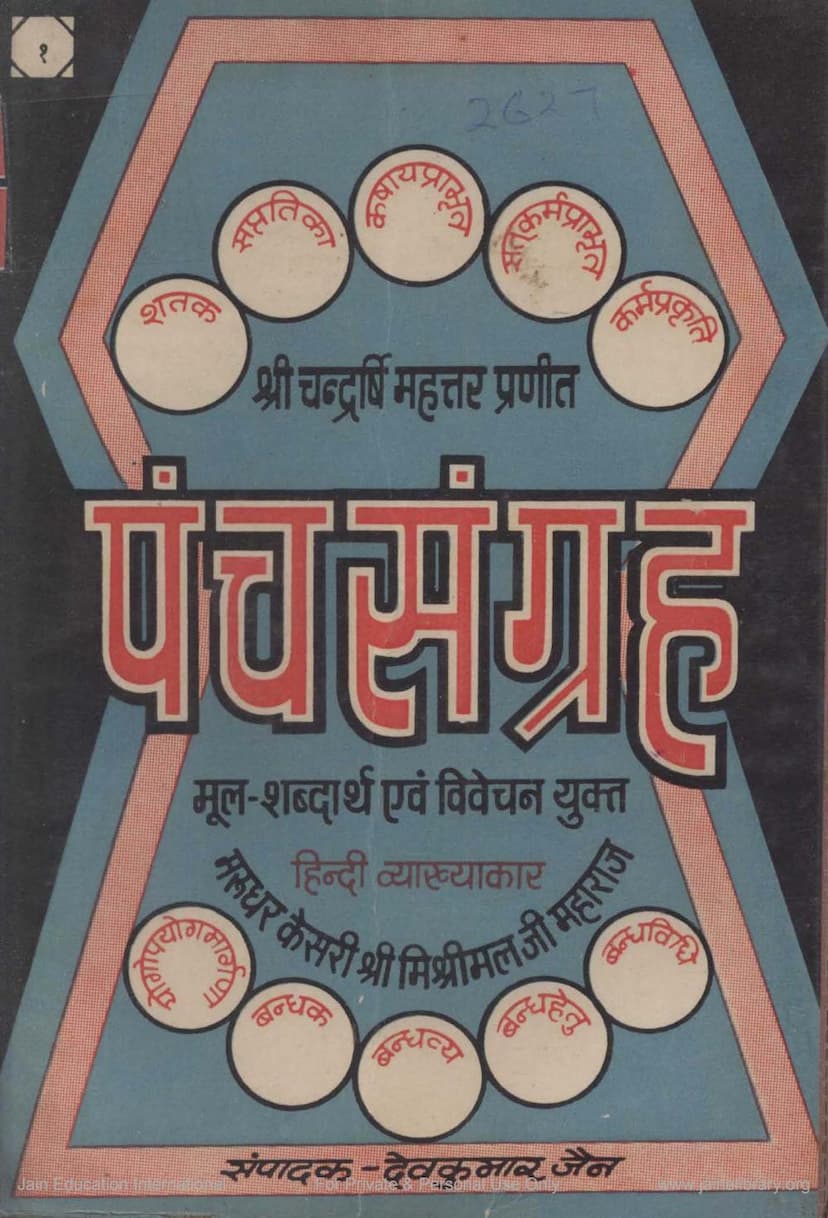Panchsangraha Part 01
Added to library: September 2, 2025

Summary
Here's a comprehensive summary of "Panchsangraha Part 01" based on the provided text:
Panchsangraha Part 01: A Summary
Title: Panchsangraha Part 01 (योगोपयोगमार्गणा अधिकार) Author: Acharya Chandrashi Mahattar Commentator: Late Marudhar Kesari Pravartak Shri Mishrimlji Maharaj Compiler/Supervisor: Shri Sukhunmuni Ji Maharaj Editor: Shri Devkumar Jain Publisher: Acharya Shri Raghunath Jain Shodh Sansthan, Jodhpur
Overview:
This volume, the first part of the "Panchsangraha," is a profound work on Jain Karma theory. It is a compilation of five significant ancient Jain texts by Acharya Chandrashi Mahattar (estimated 8th-10th century CE), aiming to preserve and present this complex knowledge in a more accessible manner. The "Panchsangraha" itself is a vast work intended to be completed in ten volumes, with this first part focusing on the Yoga-Upayoga-Margana Adhikar (Chapter on the investigation of Yoga and Upayoga).
Key Themes and Content:
-
Importance of Karma Theory: The introductory sections emphasize that understanding the Karma Siddhanta is crucial for grasping the essence of Jain philosophy. The text highlights that karma is the fundamental cause of the soul's transmigration and suffering. While other philosophies may attribute cosmic diversity and suffering to divine will, Jainism identifies the soul (Jiva) and its actions (karma) as the primary cause.
-
The Nature of Karma: Karma is described as a material substance (Pudgala) that, when acted upon by the soul due to passions like attachment and aversion, becomes powerful enough to bind the soul itself.
-
The "Panchsangraha" Title: The name "Panchsangraha" is justified in two ways:
- It is a compilation of five principal ancient texts: Shataka, Saptatika, Kashayaprabhrita, Satkarmaprabhrita, and Karmaprakriti.
- The book is divided into five main sections or "doors" (dwaras): Yoga-Upayoga-Margana, Bandhak (the binder), Bandhya (that which is bound), Bandhahetu (causes of bondage), and Bandhavidhi (the method of bondage).
-
Yoga and Upayoga: This specific volume delves into the first "door," Yoga-Upayoga-Margana.
- Yoga: Defined as the soul's vital energy (Virya) or its modifications and movements, which drive actions like running, jumping, etc. It is also described as the force that enables the soul to grasp karmic particles. Yoga is classified into three main types based on the instruments of action: Manoyoga (mental activity), Vachanyoga (verbal activity), and Kayayoga (physical activity). These further branch into fifteen specific types (four for mind, four for speech, and seven for body).
- Upayoga: Refers to the soul's consciousness (Chetana) that engages in knowing and perceiving. It is the soul's essential characteristic. Upayoga is divided into two main categories:
- Sakaropayoga (Jnana): Knowledge, which involves knowing the specifics of an object. It is further divided into five types of right knowledge (Mati, Shrut, Avadhi, Manahparyaya, Kevala Jnana) and three types of wrong knowledge (Mati-ajñana, Shrut-ajñana, Vibhanga Jnana), totaling eight types.
- Anakaropayoga (Darshana): Perception, which involves a general, undifferentiated awareness of an object. It is classified into four types: Chakshu Darshana (sight), Achakshu Darshana (perception through other senses/mind), Avadhi Darshana, and Kevala Darshana.
-
The Framework of Investigation: The Yoga and Upayoga are then analyzed within the framework of Jivasthana (states of existence based on physical development and senses), Margana-sthana (states of existence based on the soul's activities and states), and Gunasthana (stages of spiritual development).
- Jivasthana: Relates to the different types of embodied souls, categorized by the number of senses they possess and their stages of development (e.g., one-sensed, two-sensed, etc., including specific classifications like subtle/gross, sentient/non-sentient, complete/incomplete). The text details fourteen primary Jivasthanas and their variations.
- Margana-sthana: These are 62 paths or modes of investigation into the soul's existence, encompassing categories like Gati (destination – hellish, animal, human, divine), Indriya (senses), Kaya (body types), Yoga, Veda (gender), Kashaya (passions), Jnana (knowledge), Samyama (restraint), Darshana (perception), Lेश्या (color/mental states), Bhavya (destined for liberation), Samyaktva (right faith), Samjni (sentient), and Ahara (nutrition).
- Gunasthana: These are 14 stages of spiritual progress, from the lowest state of delusion (Mithyatva) to the highest state of liberation (Ayogikevali). The volume describes the specific Yogas and Upayogas that are possible or impossible at each of these stages.
-
Detailed Analysis: The text meticulously outlines the presence or absence of different types of Yoga and Upayoga within each of the 62 Margana classifications, considering their sub-categories. It also specifies which Yogas and Upayogas are associated with specific Gunasthanas. This detailed cross-referencing provides a complex but comprehensive understanding of the soul's potential states.
-
Commentary and Presentation: The current edition is a Hindi commentary on the original Prakrit text, enriched with a detailed explanation (Vichar) of the original verses. The commentary is attributed to the revered Acharya Mishrimlji Maharaj, whose dedication to spreading Jain knowledge, even in his advanced age, is highly praised. The editing by Devkumar Jain ensures clarity and accessibility.
-
Historical Context and Purpose: The publication of this text is seen as reclaiming a significant but partially lost treasure of Jain Karma literature. Acharya Chandrashi Mahattar undertook this compilation because he foresaw the diminishing accessibility of the original, more complex texts. The goal is to benefit sincere seekers of Jain philosophy.
Overall Significance:
"Panchsangraha Part 01" is a vital contribution to Jain scholarship, making a complex and foundational aspect of Jain philosophy—the intricate workings of karma as influenced by the soul's activities and states—available through a detailed Hindi commentary. It serves as an essential resource for those studying Jain Karma Siddhanta.